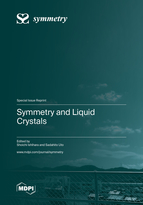Symmetry and Liquid Crystals
A special issue of Symmetry (ISSN 2073-8994). This special issue belongs to the section "Chemistry: Symmetry/Asymmetry".
Deadline for manuscript submissions: closed (31 January 2023) | Viewed by 24566
Special Issue Editors
Interests: chemical structure and physical properties; alignment control and device characteristics of liquid crystal molecules
Special Issue Information
Dear Colleagues,
More than 50 years have passed since the liquid crystal (LC) display was proposed, and the market size is now growing to reach 100 billion US dollars. In addition, recently, research into the practical application of ferroelectric LC devices and cholesteric LC devices have been vigorously conducted. Examples of the former include a LiDAR (light detection and ranging) scanner and goggles for virtual reality entertainment, and an example of the latter includes an exhalation sensor that can detect diseases. However, many things have not yet been clarified in terms of LC configuration and physical properties.
In an LC in which a uniform layered structure or a helical structure is spatially modulated, or in an LC-polymer composite, by appropriately designing the coordination of the constituent molecules and units, it may be possible to obtain an ultra-fast response, bistability, or novel electro-optic effect that cannot be expected with conventional LC devices. In addition, it is said that human biomembranes have a smectic LC structure, and basic research in this field will lead to future bioelectronics applications.
This Special Issue of Symmetry features articles about LCs, or LC-polymer composites, with symmetry as the unifying theme. We are soliciting contributions that covering a broad range of topics, including the latest theory and experimental work on the formation of LC superstructures such as blue phase and cubic phase; dynamics of the phase separation of a composite system of LC and polymer; latest research on smectic, cholesteric, and ferroelectric LCs; molecular dynamics simulation of LC configuration and its physical properties; and symmetry and asymmetry seen in LC displays.
Submit your paper and select the Journal “Symmetry” and the Special Issue “Symmetry and Liquid Crystals” via: MDPI submission system. Our papers will be published on a rolling basis and we will be pleased to receive your submission once you have finished it.
Prof. Dr. Shoichi Ishihara
Prof. Dr. Sadahito Uto
Guest Editors
Manuscript Submission Information
Manuscripts should be submitted online at www.mdpi.com by registering and logging in to this website. Once you are registered, click here to go to the submission form. Manuscripts can be submitted until the deadline. All submissions that pass pre-check are peer-reviewed. Accepted papers will be published continuously in the journal (as soon as accepted) and will be listed together on the special issue website. Research articles, review articles as well as short communications are invited. For planned papers, a title and short abstract (about 100 words) can be sent to the Editorial Office for announcement on this website.
Submitted manuscripts should not have been published previously, nor be under consideration for publication elsewhere (except conference proceedings papers). All manuscripts are thoroughly refereed through a single-blind peer-review process. A guide for authors and other relevant information for submission of manuscripts is available on the Instructions for Authors page. Symmetry is an international peer-reviewed open access monthly journal published by MDPI.
Please visit the Instructions for Authors page before submitting a manuscript. The Article Processing Charge (APC) for publication in this open access journal is 2400 CHF (Swiss Francs). Submitted papers should be well formatted and use good English. Authors may use MDPI's English editing service prior to publication or during author revisions.
Keywords
- Latest LC technology on blue phase
- New evolution of ferroelectric LC
- Cholesteric LC devices
- Molecular dynamics simulation
- LC configuration and physical properties
- LC configuration and device characteristics
- Entropy and order parameter
- Phase separation dynamics in a mixed system
- Symmetry and asymmetry seen in LC displays






